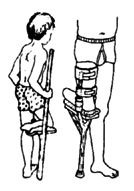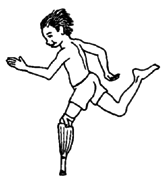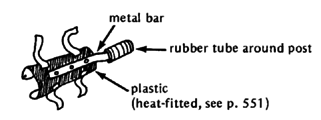CHAPTER 27
Amputations
An amputation is the loss of some part of the body. Rarely, children are born without one or both hands or feet. More often, children lose an arm or leg because of accidents. Or limbs must be cut off because of advanced bone infections (see Page 160) or dangerous tumors (cancer).
Deciding what to do for a child with an amputation depends on a number of things, including the age of the child at the time of amputation, the amount of amputation, and above all, what the child (and parents) want and accept.

|

|

If she was born that way and is given an artificial limb early, she will usually accept it and keep using it. |
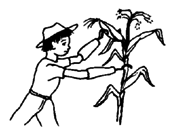
He will probably want and accept hooks, or whatever can help him hold things better. |
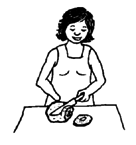
But if her hand was amputated as an older child or she has gone for a long time without an artificial limb ... ... she may prefer to keep using the stump, and refuse a limb even if one is made for her. |
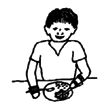
Until he can get gripping hooks, figure out ways to attach tools and utensils to his stumps so he can do more for himself. |
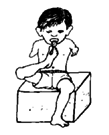
A child with high arm amputations from birth often learns to use his feet almost as well as his hands. |
|
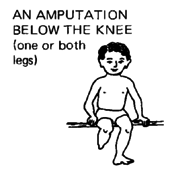
|
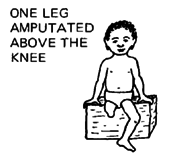
|

He should get an artificial leg as soon after the amputation as possible-or by one year of age. |

Up to age 10 (or more) she can walk well with a straight leg (no knee joint). |

A growing child will often need a new, larger limb. Therefore, try to fit him with low-cost limbs that are easy to replace. |

When older, she may prefer and will often walk better on a leg with a knee joint (if the family or program can pay for it and can keep replacing it as the child grows). |

Limbs with detachable feet - although often expensive - can be lengthened. |
|
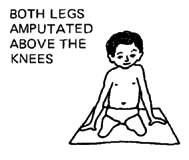
|
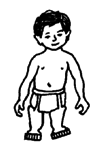
When very young, he may move about most easily on short 'stump' limbs. |
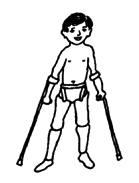
When older, he may prefer longer limbs that make him as tall as other children - even if this means using crutches. Children with very high amputation of the legs may do best in wheelchairs. |
CARE OF THE AMPUTATED LIMB
The goals in caring for the stump are to maintain a good shape and good position for fitting an artificial limb. This means taking active steps to:
- avoid swelling,
- keep the full range of motion (prevent contractures), and
- maintain strength.
WRAPPING THE STUMP

To prevent swelling and keep a good shape for fitting an artificial limb, it is important to wrap the newly amputated limb for a long time after it has been cut off.
The leg should be wrapped in a way that squeezes the liquid in the leg upward (rather than trapping it at the end). Use an elastic bandage in this manner:
Below knee

Above knee

ELEVATING THE STUMP
In addition to being wrapped, a newly amputated limb should be kept lifted high up most of the time. Avoid spending a lot of time with the arm or leg hanging down.

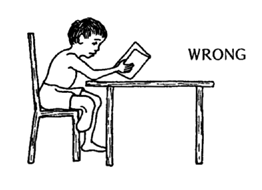
PREVENTION of contractures
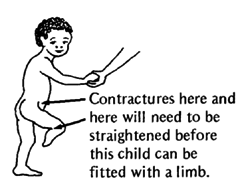
A child with an amputated leg does not use his leg normally. He usually keeps it bent, and he tends to develop contractures of the hip or knee (or both).
Therefore, special positioning and exercises are needed to prevent contractures and maintain full range of motion (see Chapter 42).
POSITIONS
Encourage positions that keep the joints stretched, and avoid those that keep the joint bent.
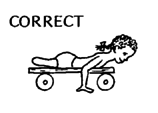
|
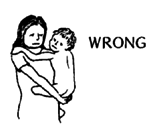
|
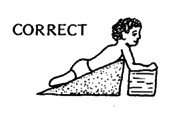
|
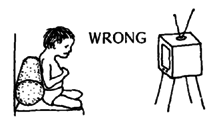
|
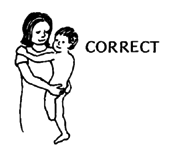
|
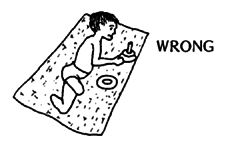
|
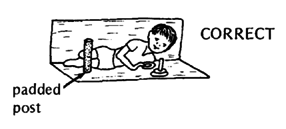
|
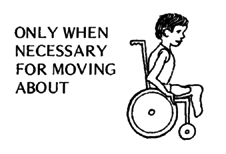
|

|

|
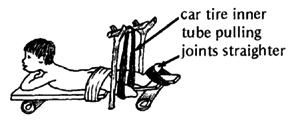
If contractures have already developed, try to position the child in ways that stretch them.
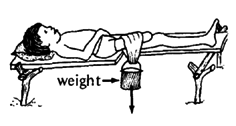
STRETCHING EXERCISES
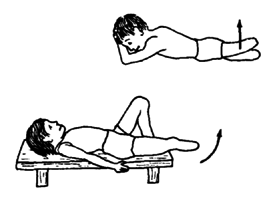
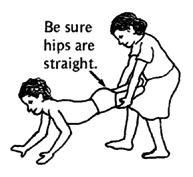
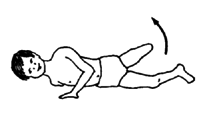
STRENGTHENING EXERCISES
Try to strengthen especially those muscles that straighten the joints, and those muscles needed for walking.

| WARNING about walking aids
Walking aids or artificial limbs, like these, that keep the stump bent may be useful until the child can get a limb that keeps the joint straight. However, it is very important that the child do stretching and strengthening exercises daily if he uses a bent-joint aid.
With a well-fitted stump-in-socket limb, normal activity usually provides all the stretching and exercise that are needed.
Instructions for making simple stump-in-socket limbs using bamboo and other local materials are in Chapter 67. |
ALTERNATIVES FOR A CHILD WITH AMPUTATED HANDS

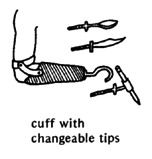
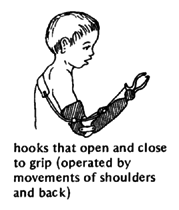
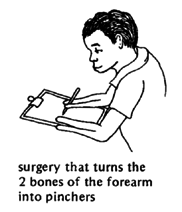 See
page 330
See
page 330


This is a grasping aid for a child whose fingers have been lost but the base of the hand and wrist joint remain.

| The type of aid a child and her parents choose for an amputation will depend on several things, such as availability, cost, usefulness, looks, and local cultural factors. For help in choosing an appropriate aid, see Chapter 56, "Making Sure Aids and Procedures Do More Good Than Harm," especially pages 531 and 532. |

